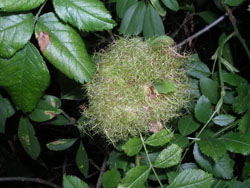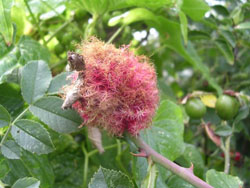A Spectular Plant Gall
At this time of year plant galls (cecidia) are so numerous and varied that it is almost impossible to take a walk by a hedgerow and not notice at least a few varieties such as Oak Apples, Spangle Galls on Oak leaves, Bigbud on blackcurrants, red "Bean" galls on willow leaves and Witches' Brooms, like clusters of twigs, on Birch, to name but a few. Galls arise as a result of an attack by a parasite such as an insect, fungus, mite, nematode (eelworm) or bacteria to which the plant responds by producing an abnormal increase in the number of cells around the area of infection, or by the cells themselves becoming abnormally enlarged. The gall is produced wholly by the plant alone - the parasite plays no part in it apart from providing the stimulus. Galls arise as a result of an attack by a parasite such as an insect, fungus, mite, nematode (eelworm) or bacteria to which the plant responds by producing an abnormal increase in the number of cells around the area of infection, or by the cells themselves becoming abnormally enlarged. The gall is produced wholly by the plant alone - the parasite plays no part in it apart from providing the stimulus.
Some galls are not only extremely attractive to look at but have evocative names as well. The photographs included here are of a singularly beautiful gall that appears on wild rose in late Summer and rejoices in the name of "Robin's Pincushion". Examples can be found in most years in our area, the path that runs by the stream from Brookside Surgery to the Woods being a particularly likely spot. It is caused by a gall wasp, Diplolepis rosae, The wasp lays its eggs in Spring in unopened buds, and the plant responds by producing a mass of up to 60 chambers surrounded by a mass of green filaments, supposed by those of a fanciful imagination to resemble a pincushion! In late Summer the gall assumes a beautiful red hue, sometimes orange and can be up to 10cms in diameter, after which it turns brown and forms the overwintering and pupating quarters for the larvae, which emerge the following May. Other country names are Bedeguar gall and Moss gall and it was once supposed that the gall possessed medicinal properties - bedeguar tea was supposed to cure Diarrhoea in cattle! In late Summer the gall assumes a beautiful red hue, sometimes orange and can be up to 10cms in diameter, after which it turns brown and forms the overwintering and pupating quarters for the larvae, which emerge the following May. Other country names are Bedeguar gall and Moss gall and it was once supposed that the gall possessed medicinal properties - bedeguar tea was supposed to cure Diarrhoea in cattle!
The greener photograph above, shows what it is like when still growing on the path 'twixt Brookside surgery and the woods, by the stream. The red photograph left, shows a more developed plant along Carter's Hill Lane, off Mole Road. Click on either photograph to see a larger version.
Thanks to Alan Broodbank for this article and pictures. |